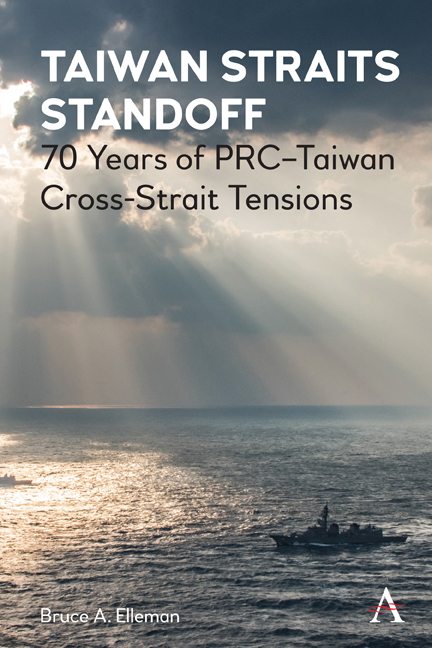Book contents
- Frontmatter
- Dedication
- Contents
- List of Illustrations
- Introduction: Stalemate along the Taiwan Straits, 1949–2020
- 1 The Two Chinas and the Battle for Control of Offshore Islands
- 2 President Harry S. Truman’s Decision to Protect Taiwan
- 3 The First Taiwan Strait Crisis, 1954–55
- 4 The Evacuation of the Dachen Islands, 1955
- 5 The Second Taiwan Strait Crisis, 1958
- 6 The US Threat to Use Atomic Weapons
- 7 Using Taiwan to Undermine the Sino-Soviet Alliance
- 8 Taiwan during the Cold War and Afterward
- Conclusions: The Taiwan Strait’s Strategic Significance Today
- Appendix: Naval Terms and Acronym List
- Selected Bibliography
- Index
Conclusions: The Taiwan Strait’s Strategic Significance Today
- Frontmatter
- Dedication
- Contents
- List of Illustrations
- Introduction: Stalemate along the Taiwan Straits, 1949–2020
- 1 The Two Chinas and the Battle for Control of Offshore Islands
- 2 President Harry S. Truman’s Decision to Protect Taiwan
- 3 The First Taiwan Strait Crisis, 1954–55
- 4 The Evacuation of the Dachen Islands, 1955
- 5 The Second Taiwan Strait Crisis, 1958
- 6 The US Threat to Use Atomic Weapons
- 7 Using Taiwan to Undermine the Sino-Soviet Alliance
- 8 Taiwan during the Cold War and Afterward
- Conclusions: The Taiwan Strait’s Strategic Significance Today
- Appendix: Naval Terms and Acronym List
- Selected Bibliography
- Index
Summary
Tensions during the 1950s between the PRC and Taiwan were focused mainly on offshore islands in or near the Taiwan Strait. The US government was concerned that a spark in this critical theater might erupt into war, perhaps even a global war between the United States and the Sino-Soviet “monolith.” Washington usually sought to deescalate tensions over the offshore islands through its diplomatic relations with Taiwan. But at other times the US government actively sought to exert military pressure—by means of “unleashing Chiang”—in order to force the PRC to reallocate military units away from north and move them to the south. As Senator Alexander Smith told Secretary of State Dulles during April 1955, if Korea and Indochina were the two flanks then Taiwan was the center, and that “we should keep open a threat to the center in order to protect the two flanks.” In this regard, the Taiwan Patrol Force acted much like a Vernier light switch, allowing the USN to “dial” up or down cross-strait tensions to suit US larger policy objectives throughout East Asia.
Truman's refusal to become involved in China's civil war saved the United States from becoming bogged down in a quagmire. On January 11, 1949, the NSC explained that while the “objective of the U.S. with respect to China is the eventual development by the Chinese themselves of a unified, stable and independent China friendly to the U.S.,” this goal was “not likely to be accomplished by any apparent Chinese group or groups within the foreseeable future.” On September 26, 1952, Truman received a fan letter quoting Republican Senator Lehman from a speech the previous day as admitting that China “could have been saved, if at all, [only] by all-out military intervention on our part.” Not only would the United States have “become bogged down in the immense expanse of China, in a war to keep Chiang-Kai-Shek in power, [but it] […] would have cost us millions of men and billions of dollars.”
US diplomacy with Chiang Kai-shek proved to be one of the greatest challenges. As the Department of State warned on January 19, 1949, when working with Taiwan the “choice is not between satisfactory and unsatisfactory courses of action but rather of the least of several evils or an amalgam of the lesser of them.”
- Type
- Chapter
- Information
- Taiwan Straits Standoff70 Years of PRC–Taiwan Cross-Strait Tensions, pp. 145 - 160Publisher: Anthem PressFirst published in: 2021

